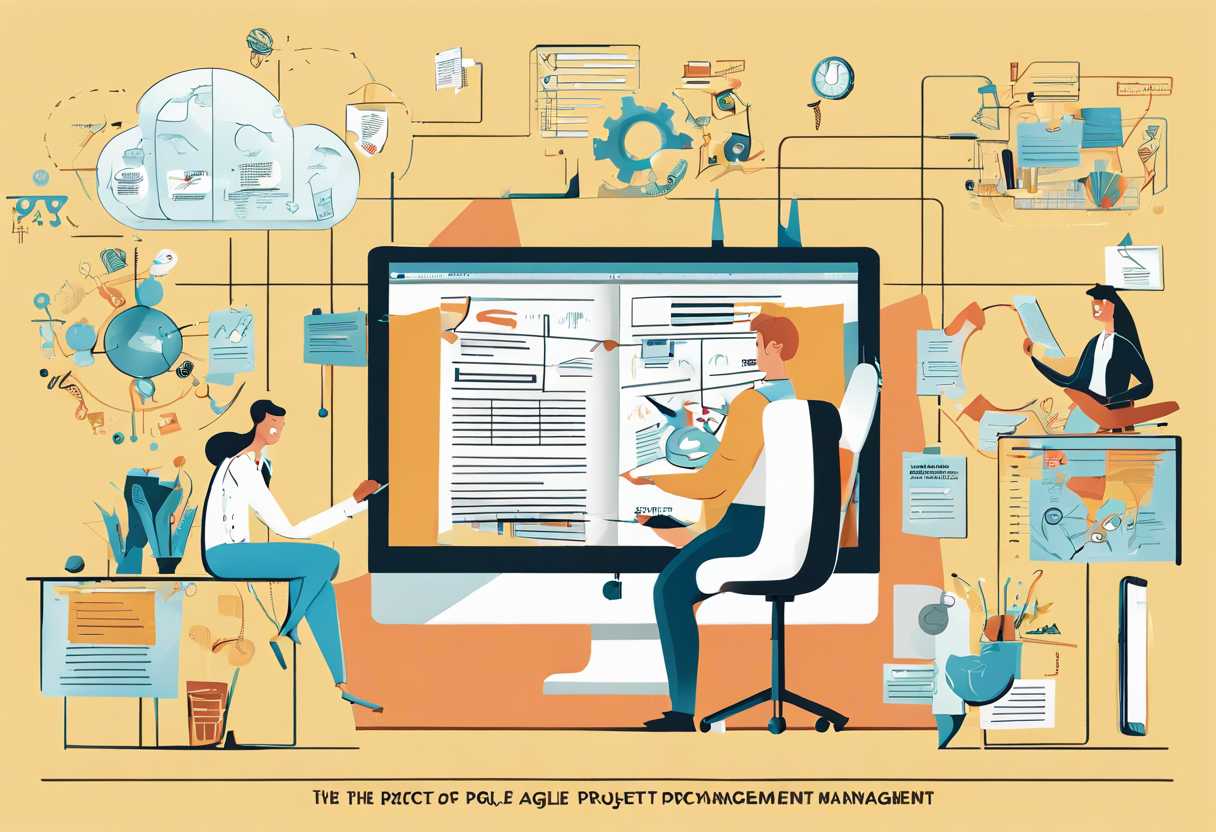Are you looking to streamline your project management processes and improve overall efficiency within your organization? Agile processes may be the solution you’ve been searching for. In this blog post, we will delve into the fundamentals of Agile processes, explore how to effectively implement them within your organization, and discuss the numerous benefits they offer for project management. We will also address the common challenges associated with adopting Agile processes and provide best practices for sustaining them in the long term. Whether you’re new to Agile or looking to enhance your existing processes, this post will provide valuable insights to help you optimize your project management approach.
Understanding the Fundamentals of Agile Processes
The Agile Methodology: A Brief Overview
Agile is a project management approach that emphasizes flexibility, collaboration, and customer satisfaction. It is based on iterative and incremental development, allowing teams to respond to changes and deliver high-quality products efficiently. Agile processes prioritize individuals and interactions over processes and tools, working software over comprehensive documentation, customer collaboration over contract negotiation, and responding to change over following a plan.
Key Principles of Agile Processes
Agile processes are guided by a set of principles that shape the way teams work and deliver value. These principles include customer satisfaction through early and continuous delivery of valuable software, welcoming changing requirements, delivering working software frequently, and maintaining a sustainable pace. By adhering to these principles, teams can adapt to evolving needs and deliver products that meet customer expectations.
Benefits of Implementing Agile Processes
Implementing Agile processes offers numerous benefits for organizations and teams. Some of the key advantages include improved flexibility and adaptability, faster time to market, increased collaboration and communication, higher quality products, and greater customer satisfaction. By embracing Agile, organizations can enhance their ability to respond to change and deliver value to their customers more effectively.

Implementing Agile Processes in Your Organization
The Benefits of Agile Processes
Implementing agile processes in your organization can bring numerous benefits. Firstly, it allows for greater flexibility and adaptability, enabling teams to respond quickly to changes in the market or customer needs. *Agile processes also promote collaboration and communication among team members, leading to improved productivity and innovation. Additionally, agile methodologies emphasize delivering value to customers, which can result in higher customer satisfaction and loyalty.*
Key Steps for Implementing Agile Processes
When implementing agile processes in your organization, it’s important to follow key steps to ensure success. *First, it’s crucial to gain buy-in from leadership and stakeholders to support the transition to agile methodologies. Next, teams should undergo training to understand the principles and practices of agile. It’s also essential to establish clear goals and metrics to measure the effectiveness of agile processes. Finally, regular retrospectives and continuous improvement are vital to refine and optimize agile practices.*
Measuring the Success of Agile Implementation
Measuring the success of agile implementation can be done through various metrics. *Some common metrics include velocity, which measures the amount of work completed in a sprint, and cycle time, which tracks the time it takes to complete a task from start to finish. Additionally, customer satisfaction surveys and feedback can provide valuable insights into the impact of agile processes on delivering value to customers.* Regularly tracking and analyzing these metrics can help organizations gauge the effectiveness of their agile implementation and make necessary adjustments.

The Benefits of Agile Processes for Project Management
Increased Flexibility
One of the key benefits of using agile processes for project management is the increased flexibility it provides. Agile methodologies allow for changes to be made throughout the project, which is especially beneficial in industries where requirements are constantly evolving. This flexibility enables teams to adapt to new information and make adjustments as needed, ultimately leading to a more successful project outcome.
Improved Communication and Collaboration
Agile processes emphasize regular communication and collaboration among team members, stakeholders, and customers. This open and transparent communication fosters a better understanding of project goals and requirements, leading to improved decision-making and problem-solving. By working closely together, teams can identify and address issues more effectively, ultimately leading to a more efficient and successful project.
Enhanced Quality and Customer Satisfaction
By breaking down projects into smaller, manageable tasks and continuously delivering working products, agile processes help ensure that the final deliverables meet high-quality standards. This iterative approach allows for regular feedback from stakeholders and customers, enabling teams to make necessary adjustments and improvements throughout the project lifecycle. As a result, agile methodologies often lead to higher levels of customer satisfaction and a greater likelihood of meeting project objectives.
Overcoming Challenges in Adopting Agile Processes
Resistance to Change
One of the biggest challenges in adopting agile processes is the resistance to change from team members and stakeholders. Many people are comfortable with traditional project management methods and may be hesitant to embrace a new approach. To overcome this challenge, it’s important to communicate the benefits of agile, provide training and support, and involve team members in the decision-making process. *Creating a culture of openness and transparency can help to alleviate fears and build trust in the new process.*
Lack of Understanding
Another common challenge is the lack of understanding about agile processes and how they work. This can lead to confusion, frustration, and ultimately, failure to implement agile successfully. To address this challenge, it’s essential to provide comprehensive training and education on agile principles and practices. *Clear communication and regular updates can help to ensure that everyone is on the same page and understands their role in the agile process.*
Organizational Structure
The existing organizational structure can also pose a challenge to adopting agile processes. Traditional hierarchies and siloed departments may not align with the collaborative and cross-functional nature of agile. To overcome this challenge, organizations may need to restructure or reorganize to better support agile teams. *Creating dedicated agile teams, breaking down silos, and empowering employees to make decisions can help to create an environment that is conducive to agile processes.*
Best Practices for Sustaining Agile Processes in the Long Term
Continuous Improvement
One of the key best practices for sustaining agile processes in the long term is to prioritize continuous improvement. This means regularly evaluating the effectiveness of your agile processes and making adjustments as needed. By embracing a mindset of continuous improvement, teams can ensure that their agile processes remain relevant and effective over time. This can involve soliciting feedback from team members, conducting regular retrospectives, and actively seeking out opportunities for improvement.
Empowering Teams
Another important best practice for sustaining agile processes in the long term is to empower teams to make decisions and take ownership of their work. Agile processes are built on the idea of self-organizing, cross-functional teams, and it’s important to maintain this structure over time. By empowering teams to make decisions and take ownership of their work, organizations can ensure that their agile processes remain flexible and responsive to change. This can involve providing teams with the autonomy to make decisions, fostering a culture of trust and collaboration, and ensuring that teams have the resources and support they need to be successful.
Measuring and Monitoring Performance
Measuring and monitoring performance is also critical for sustaining agile processes in the long term. By tracking key metrics and performance indicators, organizations can gain valuable insights into the effectiveness of their agile processes and identify areas for improvement. This can involve tracking metrics such as cycle time, lead time, and throughput, as well as conducting regular performance reviews and retrospectives. By measuring and monitoring performance, organizations can ensure that their agile processes remain aligned with their goals and objectives, and make data-driven decisions to drive continuous improvement.
Conclusion
As we conclude our discussion on Agile processes, it is evident that understanding the fundamentals and implementing Agile processes in your organization can bring about numerous benefits for project management. From increased flexibility and adaptability to improved collaboration and faster delivery, Agile processes have proven to be a game-changer for many businesses.
However, it’s important to acknowledge that adopting Agile processes comes with its own set of challenges. Overcoming these challenges requires a commitment to best practices and a sustained effort to embed Agile principles into the fabric of your organization.
By following the best practices for sustaining Agile processes in the long term, such as fostering a culture of continuous improvement and providing ongoing training and support, your organization can reap the full rewards of Agile methodologies.
Ultimately, the success of Agile processes lies in the hands of the people who embrace and champion this approach. It requires a shift in mindset, a willingness to adapt, and a dedication to continuous learning and improvement.
As you embark on your Agile journey, we encourage you to stay committed to the principles and practices we’ve discussed. Embrace the challenges, celebrate the successes, and never lose sight of the transformative power of Agile processes in driving your organization towards greater efficiency and success.
Thank you for joining us on this exploration of Agile processes. We hope you found valuable insights and inspiration to take your organization’s project management to the next level.

